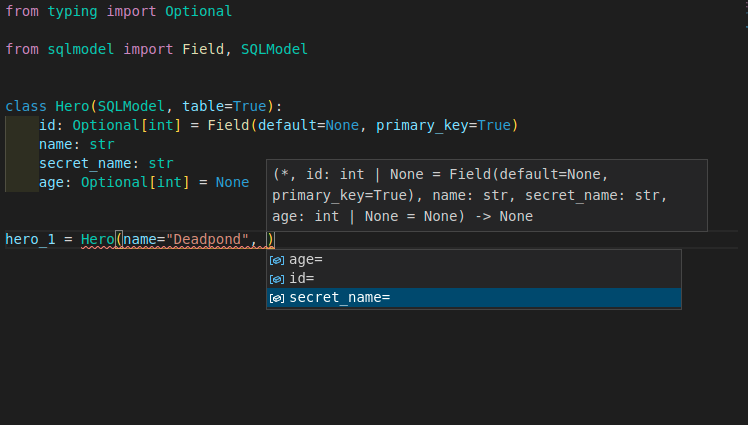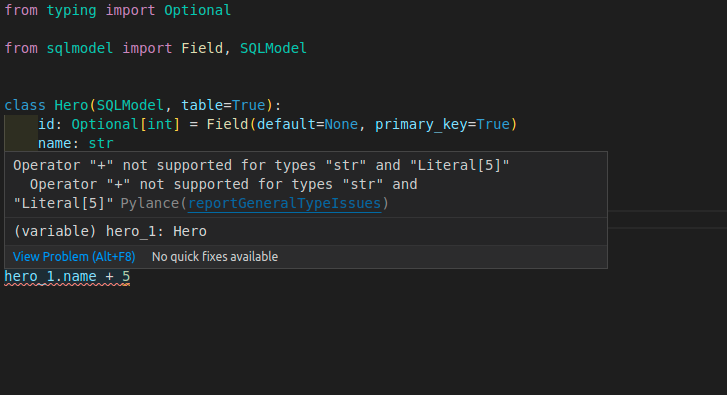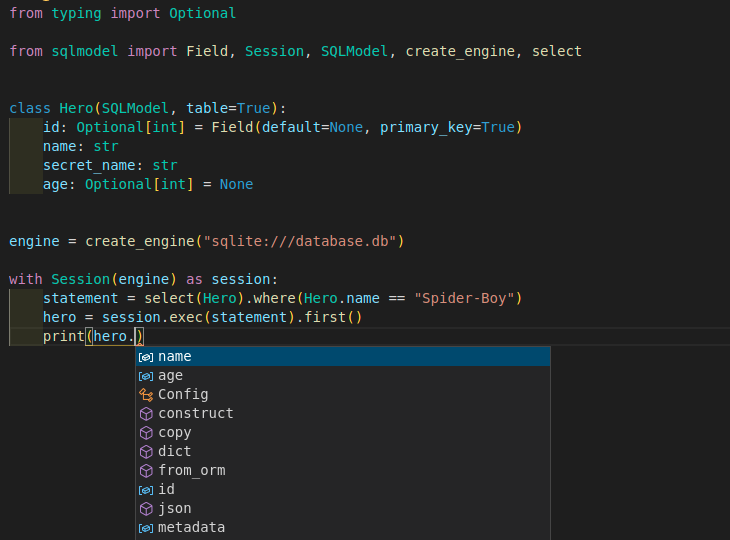SQLModel, SQL databases in Python, designed for simplicity, compatibility, and robustness.
Documentation:https://sqlmodel.tiangolo
Source Code:https://github /tiangolo/sqlmodel
SQLModel is a library for interacting with SQL databases from Python code, with Python objects. It is designed to be intuitive, easy to use, highly compatible, and robust.
SQLModelis based on Python type annotations, and powered byPydanticandSQLAlchemy.
The key features are:
- Intuitive to write:Great editor support. Completion everywhere. Less time debugging. Designed to be easy to use and learn. Less time reading docs.
- Easy to use:It has sensible defaults and does a lot of work underneath to simplify the code you write.
- Compatible:It is designed to be compatible withFastAPI,Pydantic, and SQLAlchemy.
- Extensible:You have all the power of SQLAlchemy and Pydantic underneath.
- Short:Minimize code duplication. A single type annotation does a lot of work. No need to duplicate models in SQLAlchemy and Pydantic.
SQLModelis designed to simplify interacting with SQL databases inFastAPIapplications, it was created by the sameauthor.😁
It combines SQLAlchemy and Pydantic and tries to simplify the code you write as much as possible, allowing you to reduce thecode duplication to a minimum,but while getting thebest developer experiencepossible.
SQLModelis, in fact, a thin layer on top ofPydanticandSQLAlchemy,carefully designed to be compatible with both.
A recent and currently supported version of Python (right now,Python supports versions 3.6 and above).
AsSQLModelis based onPydanticandSQLAlchemy,it requires them. They will be automatically installed when you install SQLModel.
$pip install sqlmodel
---> 100%
Successfully installed sqlmodelFor an introduction to databases, SQL, and everything else, see theSQLModel documentation.
Here's a quick example. ✨
Imagine you have a SQL table calledherowith:
idnamesecret_nameage
And you want it to have this data:
| id | name | secret_name | age |
|---|---|---|---|
| 1 | Deadpond | Dive Wilson | null |
| 2 | Spider-Boy | Pedro Parqueador | null |
| 3 | Rusty-Man | Tommy Sharp | 48 |
Then you could create aSQLModelmodel like this:
fromtypingimportOptional
fromsqlmodelimportField,SQLModel
classHero(SQLModel,table=True):
id:Optional[int]=Field(default=None,primary_key=True)
name:str
secret_name:str
age:Optional[int]=NoneThat classHerois aSQLModelmodel, the equivalent of a SQL table in Python code.
And each of those class attributes is equivalent to eachtable column.
Then you couldcreate each rowof the table as aninstanceof the model:
hero_1=Hero(name="Deadpond",secret_name="Dive Wilson")
hero_2=Hero(name="Spider-Boy",secret_name="Pedro Parqueador")
hero_3=Hero(name="Rusty-Man",secret_name="Tommy Sharp",age=48)This way, you can use conventional Python code withclassesandinstancesthat representtablesandrows,and that way communicate with theSQL database.
Everything is designed for you to get the best developer experience possible, with the best editor support.
Includingautocompletion:
Andinline errors:
You can learn a lot more aboutSQLModelby quickly following thetutorial,but if you need a taste right now of how to put all that together and save to the database, you can do this:
fromtypingimportOptional
fromsqlmodelimportField,Session,SQLModel,create_engine
classHero(SQLModel,table=True):
id:Optional[int]=Field(default=None,primary_key=True)
name:str
secret_name:str
age:Optional[int]=None
hero_1=Hero(name="Deadpond",secret_name="Dive Wilson")
hero_2=Hero(name="Spider-Boy",secret_name="Pedro Parqueador")
hero_3=Hero(name="Rusty-Man",secret_name="Tommy Sharp",age=48)
engine=create_engine("sqlite:///database.db")
SQLModel.metadata.create_all(engine)
withSession(engine)assession:
session.add(hero_1)
session.add(hero_2)
session.add(hero_3)
session.commit()That will save aSQLitedatabase with the 3 heroes.
Then you could write queries to select from that same database, for example with:
fromtypingimportOptional
fromsqlmodelimportField,Session,SQLModel,create_engine,select
classHero(SQLModel,table=True):
id:Optional[int]=Field(default=None,primary_key=True)
name:str
secret_name:str
age:Optional[int]=None
engine=create_engine("sqlite:///database.db")
withSession(engine)assession:
statement=select(Hero).where(Hero.name=="Spider-Boy")
hero=session.exec(statement).first()
print(hero)SQLModelwas carefully designed to give you the best developer experience and editor support,even after selecting datafrom the database:
That classHerois aSQLModelmodel.
But at the same time, ✨ it is aSQLAlchemymodel ✨. So, you can combine it and use it with other SQLAlchemy models, or you could easily migrate applications with SQLAlchemy toSQLModel.
And at the same time, ✨ it is also aPydanticmodel ✨. You can use inheritance with it to define all yourdata modelswhile avoiding code duplication. That makes it very easy to use withFastAPI.
This project is licensed under the terms of the MIT license.






